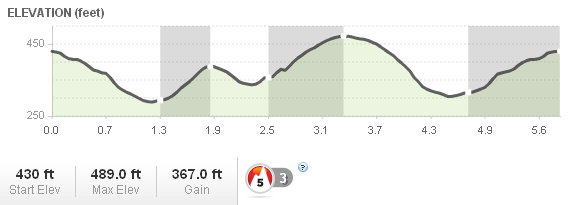Or, I'm so Glad I Chose the Jacket Instead of a Vest
When I received a Running Warehouse gift card for my birthday a couple of months ago, my first thought was that I should use it to acquire some winter-weather running apparel in anticipation of the impending cooler temperatures. As a relatively inexperienced runner, my running apparel wardrobe is still relatively scant. So, outerware of some kind would be in order. But, the common question presented itself: Should I buy a jacket or a vest for running in the cooler temperatures.
Needless to say, I chose to get a jacket, the Salomon Men's Fast III Jacket. And, I am so glad I did! I've been wearing it on every morning run this month, while the temps have hovered between 10 and 25 degrees, sometimes with strong winds.
The Reason
So, why did I choose the Salomon Fast III Jacket?
 Well, look at it. You have to admit that it's pretty stylish. And, the correlation between the Salomon brand and trail running was not unnoticed by me when comparing jackets.
Well, look at it. You have to admit that it's pretty stylish. And, the correlation between the Salomon brand and trail running was not unnoticed by me when comparing jackets. 
Also, the features and specs listed for the the Salomon Fast III jacket made a pretty good case for this piece of running apparel:
- ClimaWIND provides wind resistance, water resistance, and breathability
- SMART SKIN technology provides moisture management and high-mobility fit
- Front and back reflectivity
- Full-length, lockdown zipper with zipper garage
- 2 side zippered pockets with lockdown zipper
- Thumbholes
- Side and back stretch panels
I'd originally intended to purchase a running jacket that was brightly colored for the sake of safety on my morning runs. But, I decided not to base my decision on visiblity, since I use a light while running on well-lit sidewalks. So, although this jacket is available in three flashy colors, I went with the black option, because I thought I'd be able to wear this as casual outer ware, too.
Comfort Range
An important thing to consider when shopping for a running jacket is the temperature range at which the jacket will be protective and comfortable. Naturally, the question of comfort as it relates to temperatures is a very individual thing. So, for the sake of establishing perspective, know that my preferred attire on a sunny day with no wind and temps in the low 30s (f) consists of running shorts, a base layer tech-tee shirt, and a lightweight long-sleeve tech shirt.
Now, then, if it is 45 degrees with wind and light rain, you'll be hot in this jacket with a tech-tee underneath. But, you'll be glad you're wearing it, because the rain would be annoyingly cold otherwise.
If it is 40 degrees, sunny, and windy; you'll be hot in this jacket and wish you'd not worn it over your tech-tee.
If it is dark with temps in the mid-30s, you'll be fine wearing this jacket along with a tech-tee underneath. You could probably get away with skipping the tech-tee underneath. But, that's not very comfortable. I mean, really, if it's in the mid thirties without wind or rain, you'll be better off wearing a long-sleeve tech shirt and leaving the jacket home.
If it is dark with wind gusts up to 15 mph and temps in the low 20s, you'll want to wear this jacket with at least a long-sleeve tech shirt as a base layer. You'll be even more cozy in this jacket if you wear a short-sleeve base layer and a long-sleeve mid layer under it.
If it is dark and snowing or sleeting with temps around 20, you'll be surprised at how much more comfortable you feel than you did when you wore this jacket in the gusty wind, provided you have a long sleeve layer underneath.
If it is dark with temps in the low teens, you'll be okay as long as you have at least one long-sleeve layer beneath it.
The Verdict
I stated before that I've not had the opportunity to try out a wide variety of running clothes. So, I'm easily impressed. But, I'm pretty confident in claiming that this jacket is definitely a finely crafted piece of technical apparel. It feels lighter than a couple of my tech shirts. And, it is definitely resistant to moderate gusts of frigid wind. Wearing a jacket like this in conjunction with one or two under layers allows me to keep the bundling to a minimum while running in winter temperatures.
So, if you are looking for a lightweight, wind and water resistant jacket to wear while running, the Salomon Men's Fast III Jacket is available at Running Warehouse right now for a pretty good price.

 The park map indicates that Company Mill measures 5.8 miles. Someone else's Garmin data shows that the trail measures 5.77 miles from the Reedy Creek entrance parking lot. So, both sources concur that the trail is a little under 6 miles.
The park map indicates that Company Mill measures 5.8 miles. Someone else's Garmin data shows that the trail measures 5.77 miles from the Reedy Creek entrance parking lot. So, both sources concur that the trail is a little under 6 miles.  My Favorite Features of the Company Mill Trail:
My Favorite Features of the Company Mill Trail:

 Fast forward to a month or so ago when I decided to
Fast forward to a month or so ago when I decided to 


 So, I have this jacket that I purchased from
So, I have this jacket that I purchased from 

